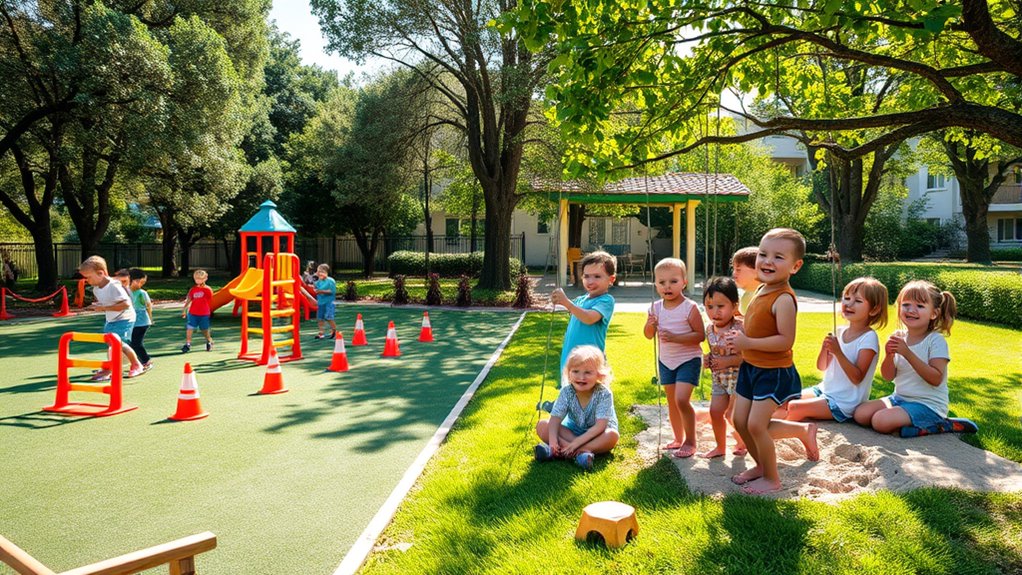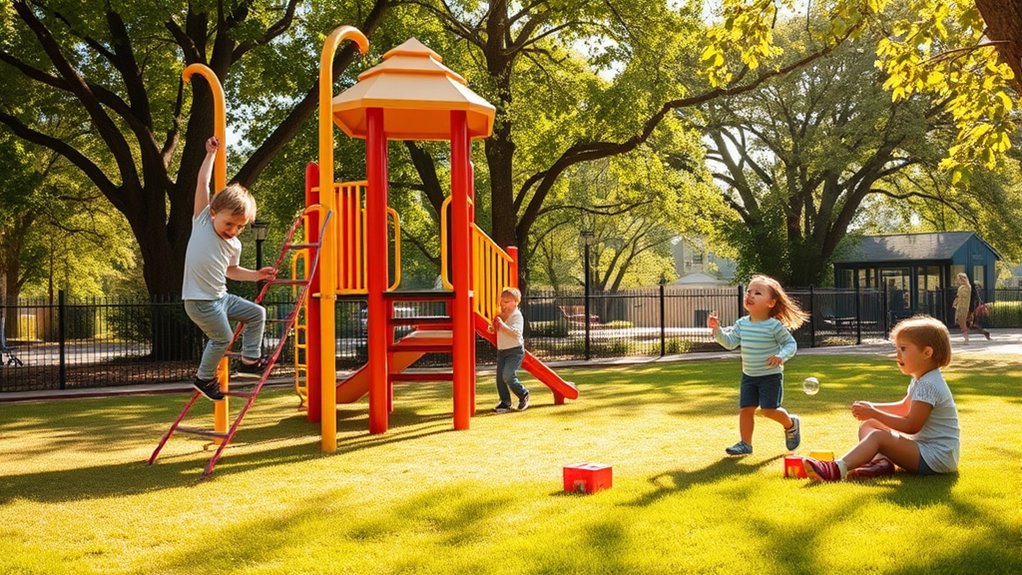Balancing structured activities and free play helps your child develop skills, creativity, and social confidence. Organize a routine that includes specific times for lessons and sports, while ensuring they have plenty of unstructured playtime to explore and invent. This mix promotes discipline and independence without stifling imagination. By creating a flexible schedule tailored to your child’s needs, you foster a well-rounded environment for growth—learning more about achieving this balance can make a big difference.
Key Takeaways
- Schedule specific times for both structured activities and free play to ensure a balanced routine.
- Incorporate diverse activities that promote creativity, problem-solving, and social skills.
- Maintain flexibility to adjust the balance based on your child’s interests and developmental needs.
- Use structured lessons to build discipline, while free play fosters imagination and independence.
- Facilitate social interactions through playdates and group activities to support well-rounded growth.

Finding the right balance between structured activities and free play is essential for your child’s development. When you provide opportunities for both, you help nurture their creative development and social skills. Structured activities, like music lessons or sports, offer a sense of discipline and teach specific skills. However, too much emphasis on these can limit your child’s ability to explore their imagination and develop independence. Free play, on the other hand, allows children to create their own rules, solve problems, and experiment with new ideas. This unstructured time is critical for fostering creativity because it encourages kids to think outside the box and use their imagination freely. It also plays a fundamental role in social skills development, as children learn to negotiate, share, and empathize with peers during play.
You should aim to create a routine that includes both types of activities. For example, scheduling specific times for lessons or organized sports ensures your child gains discipline and learns new skills. Meanwhile, setting aside ample free time lets them pursue spontaneous play, which is equally important for their growth. During free play, your child might invent games, build forts, or role-play, all of which boost their creative development. These activities challenge their brains to think flexibly and problem-solve, strengthening their cognitive abilities. Additionally, incorporating structured activities with a focus on skill development can complement free play by providing a balanced approach to learning.
Supporting your child’s social skills during free play is also essential. When children play together without strict rules or adult intervention, they learn to communicate effectively, resolve conflicts, and understand different perspectives. These experiences build confidence and help them become more socially adept. You can facilitate this by encouraging playdates, group activities, or simply providing a variety of toys and materials that invite cooperative play.
Balancing structured activities with free play also teaches your child how to manage their time and develop self-discipline while still having the freedom to explore their interests. It’s important to observe how much time your child spends engaging in each type of activity and stay flexible. If they seem overwhelmed or uninterested in structured routines, it might be time to loosen the schedule and give them more free time. Conversely, if they lack focus or motivation, adding more structured activities can provide stability and direction.
Ultimately, the goal is to create a supportive environment where your child’s creative development and social skills can flourish. By thoughtfully blending organized activities with unstructured play, you help foster well-rounded growth, confidence, and joy in learning.
Frequently Asked Questions
How Can Parents Identify the Right Balance for Their Child?
To find the right balance for your child, observe how they respond to different activities. Use time management to allocate specific periods for structured activities and free play, ensuring neither dominates. Mix activity variety to keep things engaging and avoid burnout. Pay attention to their mood and energy levels; if they seem overwhelmed or bored, adjust the schedule accordingly. Flexibility helps you tune into what works best for your child’s development.
What Are Signs of Over-Scheduling in Children?
Over-scheduling stress shows in your child’s sudden sulks, sapped energy, or skipped snacks. You might notice them resisting activities or whining more than usual. Parental awareness helps spot these signs early—watch for worn-out words, waning enthusiasm, or worried whispers. When your child’s schedule seems super tight, take the time to tune in. Recognizing the signs of over-scheduling helps you make mindful, manageable modifications, fostering happiness and healthy growth.
How Does Free Play Benefit Emotional Development?
Free play helps kids develop emotional resilience by allowing them to experience and manage their feelings in a safe space. It boosts social skills as they interact with peers, negotiate, and share. During unstructured play, you see children learn to cope with setbacks and express themselves creatively. These experiences build confidence and emotional strength, essential for traversing life’s challenges. You support their growth by encouraging ample opportunities for free play.
Are There Age-Specific Guidelines for Structured Activities?
Think of age-specific guidelines like a map guiding your child’s growth. You should choose age-appropriate activities that align with their developmental milestones, ensuring they’re challenged yet not overwhelmed. For toddlers, focus on simple, sensory-rich tasks; for older kids, introduce more complex skills. By tailoring structured activities to their age, you help them build confidence and skills at the right pace, creating a smooth journey through childhood’s exciting landscape.
How Can Schools Incorporate Both Play and Learning Effectively?
You can effectively incorporate both play and learning by carefully planning recess scheduling to guarantee kids get ample free time, fostering creativity and social skills. Offer extracurricular diversity to engage different interests, blending structured lessons with unstructured activities. This balanced approach helps students develop academically while enjoying the benefits of free play, making learning more enjoyable and well-rounded. Your thoughtful scheduling creates an environment where kids thrive through both structured and free experiences.
Conclusion
By finding the gentle middle ground between structured activities and free play, you help your kids blossom naturally. Too much of one can quietly dim their curiosity or confidence, but a thoughtful balance nurtures their growth effortlessly. Remember, sometimes the best lessons come from unplanned adventures and moments of quiet exploration. Embrace this delicate dance, and watch your children flourish with a joyful, curious spirit—like a garden thriving in just the right amount of sunlight and shade.











